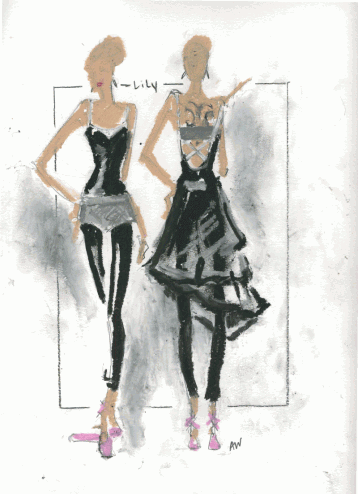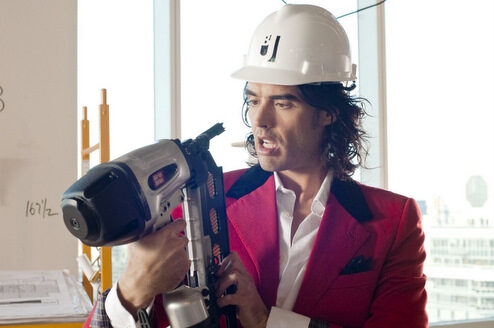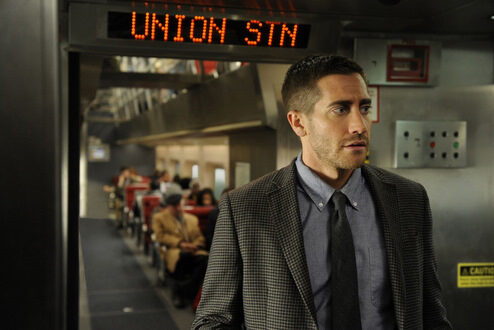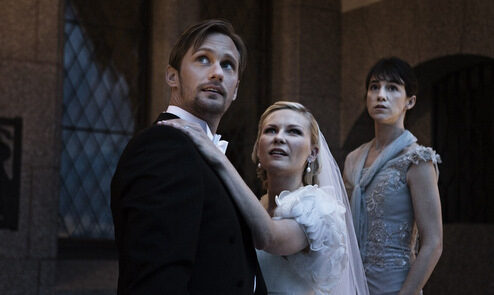Clothes on Film's 2011 Costume Design Round Up |
By no means intended as an exhaustive list, Clothes on Film ponder an overview of 2011 in costume. Concentrating on mainstream fare that those outside of big cities are likely to have seen, we consider which costumes delighted, surprised and best of all, enlightened us. Expect to spot Drive, Melancholia and Hugo on this list somewhere.
Costume encompasses every item of clothing worn on film. By strict definition costume is not ‘wardrobe’; wardrobe is what Oprah Winfrey wore on her talk show. While at Clothes on Film we embrace all forms of costume, we do have a slight bias for contemporary, although only because it is often underrepresented in the face of (admittedly dazzling) period or fantasy wear. This roundup will comprise both period and contemporary, but with very slight emphasis on the latter.

Original sketch for Black Swan by costume designer Amy Westcott.
Black Swan (released in the UK on 21st January) brought notice to costume and specifically the role of the costume designer like no other film in the past decade – at least. Of course it also brought no small amount of controversy, too. With Amy Westcott’s BAFTA nominated work overshadowed by eager press coverage of fashion designers the Mulleavy sisters’ contribution, it took an exclusive interview with Clothes on Film to set the matter straight.
One further note; Clothes on Film did attempt to conduct an interview with Kate and Laura Mulleavy but all requests were politely ignored (even after an initial email from their representation in New York claiming the sisters were ‘The costume designers of Black Swan’). Yet beyond the debate over Black Swan’s costume recognition is an entirely readable deconstruction of character, as aspiring ballet dancer Nina Sayers (Natalie Portman) metamorphosises from light to dark, sanity to insanity.

Helena Bonham Carter as Queen Elizabeth wore vintage fur coats in The King’s Speech.
The King’s Speech (released 7th January) also drew fleeting attention to the craft of costume design. A period drama, or ‘PD’ (Press Darling), on this occasion set primarily in the 1930s, remains the most popular genre for costume coverage in mainstream media. Generally there is an assumption that design budgets, costume, production, art, etc are immense, but this is rarely the case. The King’s Speech costume designer Jenny Beavan had little to work with. Some of the coats worn by Helena Bonham Carter as Queen Elizabeth were vintage, although due to the actress’ tiny hands using period gloves was impossible so they had to be custom made instead.
Jenny Beavan also had to placate the demands of Colin Firth in the title role as King George VI. Really nowhere near slim enough to be playing George VI, Firth was justly concerned about his bulging silhouette, apparently to the degree that he refused to wear a suit jacket beneath his overcoat for fear it would bulk him out. Those who attack costume designers for historical inaccuracy on film should also consider the demands of star wattage. If Oscar winning actor Colin Firth does not want to wear a jacket, he is not going to wear a jacket.

Russell Brand as childish playboy Arthur Bach. Brand’s suits and jackets were tailored by Martin Greenfield in New York.
Another real life figure represented looking their best, though in this instance purely as inspiration, was 34 year old heir to the Fiat fortune Lapo Elkann. Costume designer Juliet Polcsa used Elkann as a muse for Russell Brand’s incarnation of playboy Arthur Bach in Arthur (released 22nd April). Flamboyant Elkann conveys the perfect sense of unconformity that blends well with Brand’s own exuberant off-screen personality.
Nonetheless, Brand apparently requested his Arthur suits to be ever tighter in the waist and shorter in the jacket, meaning Polcsa had to be careful in retaining character over star. The film is full of incredible dandy suiting made exclusively by Martin Greenfield of New York, certainly the most impressive of the year; a colourful mix of seersucker and silk, plush velvet collars and surgeon’s cuffs. These exquisite suits are neatly woven into the narrative, as in one touching scene Arthur explains that he re-tailored several of his late father’s Savile Row suits to fit him.

Nucky Thompson (Steve Buscemi) pictured for once without his signature stiff crown Homburg hat.
For small screen tailoring absolutely nothing can compare to John Dunn and Lisa Padovani’s work on Boardwalk Empire with Dunn even ordering early 1920s fabrics re-spun for Nucky Thompson’s (Steve Buscemi) suits – again made by Martin Greenfield. This is the obsessive level of detail the show demanded. At this time, 1920/21 in Atlantic City, there were no flappers and no ‘dressing soft’. Boardwalk Empire is ever keen to stress its world is one on the cusp of sartorial change.
A vital component of Boardwalk Empire are its hats, particularly the signature iconography of Nucky in his stiff brim Homburg (except for a trip to Chicago where he swops it for a straw Boater – taking a little cabaret with him). Making equally important use of hats in cinema was The Adjustment Bureau (released 4th March). Every style was given hierarchical meaning by the film’s costume designer Kasia Walicka Maimone. Baseball caps, for example, represented lower ranks while fedoras were only sported by those in charge, i.e. the ‘Bureau’. These hats either bestowed power or removed it, depending on the type worn.

Jake Gyllenhaal as Colter Stevens in Source Code wearing his telltale blue denim shirt.
Sci-fi drama Source Code (released 1st April) is perhaps less readable in this way, yet costume designer Renée April does provide a few ingenious narrative clues for the audience, or for those peering intently enough anyway, i.e. the blue denim shirt that is just slightly too loose around the neck of Jake Gyllenhaal as Colter Stevens’ neck. Of course this will mean nothing to those who have not seen the film, which is what makes it so worthwhile as a sly costume titbit.
One sci-fi/comic book movie that carries minimal subtext is 1960s set X-Men: First Class (released 1st June), though mainly because it does not need to. Costume designer Sammy Sheldon, who also tackled comic book for director Matthew Vaughn with Kick Ass in 2010, paints a relatively understated picture of the sixties, more The Prisoner than The Avengers. Apart from Michael Fassbender as Erik Lehnsherr in rollneck sweaters and January Jones’ more character specific Emma Frost ensemble (her Hellfire Club uniform), X-Men: First Class dials down the camp to be more retrospective than rose-tinted vintage.

Costume designer Anna Sheppard admits she had to take into account that the 3D conversion process would dim the on-screen image when creating Captain America’s (Chris Evans) uniform.
Embracing period more openly was Captain America: The First Avenger (released 29th July). Costume designer Anna Sheppard, already well versed in the story’s 1940s setting with films such as The Pianist and Inglourious Basterds, makes scant attempt to refashion Captain America for contemporary audiences, apart from addressing that the 3D conversion process would darken colours on screen. Exploring that the superhero costume is deliberately fantastical to facilitate projection of ourselves (mundanity) into a fictional universe where anything is possible (adventure); Sheppard establishes that Steve Rogers’ (Chris Evans) generically engineered soldier is an empathetic as well as sympathetic character.
Furthermore Captain America: The First Avenger exhibits that great (perhaps none greater) symbol of masculinity on film: the plain white t-shirt. Immortalised with such potency by Marlon Brando (The Wild One) and James Dean (Rebel Without a Cause), Anna Sheppard imbues Evans’ muscular form with a sex appeal lacking – and to be fair never strived for – in his superhero costume.

Ryan Gosling exhibiting perhaps the most iconic symbol of masculinity on film, the plain white t-shirt, in Drive.
Again exploring the white t-shirt on film, here a filthy Henley reflecting the ambiguous motives and muddled soul of its protagonist (Ryan Gosling), Drive (released 23rd September) concentrates on altering our expectations of what a hero should be. Wearing a satin bomber jacket, tapered Acne jeans and brown leather driving gloves, Erin Benach’s ensemble for the ‘The Driver’ is an oddly streamlined hodgepodge suggesting, as stated in Clothes on Film’s original review, the bodywork of a car. Gosling’s costume then soils and fragments in tandem with every action beat in the story. Drive reinvents the uniform of the protector, daring us to gaze at this well worn character with fresh eyes.
Melancholia (released 30th September) has even more to say about the moral decline of its central protagonist than Drive. Costume designer Manon Rasmussen’s spectacularly bouffant wedding dress stifles depressed Justine (Kirsten Dunst) so much so that she sullies it with increasingly shameful acts. In the cold aloofness of bland couture is the only point at which Justine feels comfortable. This echoes that all responsibility for her own happiness has been removed in line with the impending and inevitable end of the world.

Kirsten Dunst as Justine in Melancholia wearing her heavily symbolic wedding dress.
Justine’s constrictive wedding dress is figuratively similar to that designed by Michael O’Connor for Jane Eyre (released 9th September). This merciless mid-19th century silhouette is a far cry from the romantic empire line of the Jane Austin era. Jane Eyre takes place in a harsh environment during cold, harsh times. O’Connor and director Cary Fukunaga avoided the more ‘pretty, pretty’ approach to costume drama, instead concentrating on colour, fabric and tone (muted, stiff and bleak). While Justine chooses to continually defile her wedding dress, Jane Eyre (Mia Wasikowska) practically tears it from her body. Both characters are consumed with an inability to allow themselves contentment; in reality they do not even understand what it is.
Recreating an era more readily associable with contemporary attire was Tinker, Tailor, Soldier, Spy (released 16th September). While not exactly setting the back pages of glossy magazines alight, even with its livelier suits being tailored by Timothy Everest, more significant is that this film remains true to its own world. Unlike the BBC’s adaptation of John le Carré’s novel in 1978, this is a period piece bringing to life a very specific class of characters: the Old Boys Network; men from the right universities or families. Even the (always female) secretaries working at spy HQ ‘The Circus’ would generally be ‘someone’s daughter’. Their fashionable frocks are costume designer Jacqueline Durran’s only obvious nod to the seventies’ more outlandish attire.

George Smiley’s (Gary Oldman) raglan raincoat in Tinker, Tailor, Solider, Spy was inspired by author Graham Greene.
Like Tinker, Tailor, Soldier, Spy, early 1960s Mississippi set drama The Help (released 26th October) implies a world of conformity whereby those who wish to fit in must dress accordingly. Director Tate Taylor, himself an actor, understands how the Southern Belles’ ensemble was indicative of who they were and consequently how they treated the black maids working for them. It was all about image; if one dressed a certain way, one should act a certain way.
Not shying away from the heavy floral patterns and bold candy stripes of the period (certainly in Mississippi), costume designer Sharen Davis could well be looking at an Oscar nomination for her contribution to The Help. Her eye catching creations, especially for monstrous Hilly (Bryce Dallas Howard) and attention to detail, the collars on maids’ uniforms for example, also their updated colour (pale blue instead of white), is worthy of recognition.

My Week With Marilyn attempted to show the less flamboyant side of the legendary Hollywood star.
Costume designer Jill Taylor worked with comparable fastidiousness on My Week with Marilyn (released 25th November), though of course was recreating a real life figure, Marilyn Monroe (Michelle Williams). Taylor presented a side of Marilyn rarely seen in her movies, the girl next door in blue jeans, plain white shirts, head scarves and trenchcoats. This is a real challenge when the subject in question is so well loved and still so misunderstood. Ditto in some respects Consolata Boyle’s costumes for power dressing advocate Margaret Thatcher (Meryl Streep) in The Iron Lady (released 30th December). Boyle re-used used the colour blue throughout to imply Thatcher’s mood.
If The Iron Lady and My Week with Marilyn featured real life icons in based-on true stories, The Artist (released 30th December) features two fictitious icons from what almost pertains to a fantasy world. The Artist is set during the tail end of the silent era in Hollywood. It is utterly delightful filmmaking, though hardly intended as documentary realism. Costume design by Mark Bridges is accurate for the era, lots of drop waist dresses and fur, but is mainly intended as romantic nostalgia.

Peppy Miller (Bérénice Bejo) and The Butler (Malcolm McDowell) in predominantly 1920s set The Artist. With The Great Gatsby on its way in 2012, this era is tipped to stay popular on catwalks and the high street.
Yet costume is also vital to the narrative. It helps reflect the inner thought processes of The Artist’s two central characters, George Valentin (Jean Dujardin) and Peppy Miller (Bérénice Bejo). In one beautifully directed scene by Michel Hazanavicius, Peppy uses the empty sleeve of George’s suit jacket to make believe him cradling her in his arms. Towards the end of the story with George’s movie career now apparently over, he pictures himself wearing full evening dress as his head is reflected on a tailor’s dummy in a shop window.
Another period film that is assuredly spectacle yet relies on intricate detail to inform character is Hugo (released 2nd December). The film’s costume designer Sandy Powell is a household name typically associated with large-scale productions featuring hundreds of extras. Hugo is no exception, though there are hidden meanings to discover, like the layered beauty of the film itself, if one peers beneath the surface.

Chloë Grace Moretz as Isabelle and Asa Butterfield as Hugo Cabret in Hugo. Patterns are employed to help keep track of characters in the busy Paris train station.
Hugo is a 3D fantasy world rooted in the physics of reality but full of possibilities. Dreams come alive, nightmares too; intense reds, blues and greens surge from the screen. Powell commented exclusively to Clothes on Film, “The colours like some of the styles were deliberately heightened as if from a child’s perspective. All the scenes of Paris seen from the station are also a storybook version of Paris rather than being totally realistic“.
Incorporating clothing on a contemporary footing was Contagion (released 21st October). With director Steven Soderbergh making a realistic film about an escalating bird flu pandemic, he employed costume designer Louise Frogley to tell as much about his characters as possible in the shortest time. Dr. Erin Mears (Kate Winslet), for example, is a committed scientist who cares nothing for fashion (i.e. smart black trousers, ski coat and trainers); whereas Dr. Leonora Orantes (Marion Cotillard), a World Health Organisation epidemiologist, is immaculately turned out in luxurious pale suits. Orantes is initially cold and aloof, one suspects someone very conscious of image, allowing her costume to soften considerably towards the end of her journey.

Saoirse Ronan as Hanna in a film layered with costume meaning.
Clothing with interpretable meaning is the craft at its most appealing, however. Director Joe Wright’s thriller Hanna (released 6th May) appears to be telling two concurrent stories. First is the tale of a teenage girl, Hanna Heller (Saoirse Ronan), raised in the wilderness then suddenly released into the world a trained assassin with as a mysterious past to decipher. Second is a fairytale in which Hanna undertakes a perilous adventure to become a princess by defeating a wicked witch and her evil trolls.
Costume designer Lucie Bates placed clues throughout Hanna validating this concept, likewise production designer Sarah Greenwood. Most are apparent in the characters Marissa (Cate Blanchett) and Hanna herself. Marrisa’s green colour palette and red hair evoke a mythical evil queen. Her trolls, styled as German neo-fascists and their ringleader Issacs (Tom Hollander) a 1980s football hooligan, are unnervingly creepy. Hanna does blossom into a princess about mid-way through the narrative when she dons make-up and a pink tutu. As Bates describes it, “This is the first time she tries to appear like a woman. She does become the fairytale princess”.

Cate Blanchett as Hanna’s nemisis and more. Some of Blanchett’s clothes were made by Giorgio Armani based on costume designer Lucie Bates’ own specifications.
There was a minor, largely unreported controversy with the costumes in Hanna that brings us neatly back to Black Swan. Much had been written in the press about how fashion designer Giorgio Armani created all of Cate Blanchett’s outfits in Hanna, although predictably this was not quite the case. Lucie Bates requested clothing from the current Armani collection but was unhappy with the pieces sent so ordered them redesigned according to her own specifications, in different colours, fabrics and fit. Certain key items, Marissa’s silk blouses for example, were actually made entirely by Bates. Costume is not fashion design, though this perception refuses to budge in some instances. Moreover with director David Fincher’s adaptation of The Girl with the Dragon Tattoo nearly upon us (26th December), there is a worthwhile debate on the subject still waiting to happen.
Many more films were released this year with memorable costumes; Submarine, Insidious, Meek’s Cutoff and There is Something About Kevin to name only four. They will no doubt be covered soon at Clothes on Film in some capacity or other, or when we hire an army of writers (this is a passionate but small scale operation). In the meantime, might we suggest resting up and preparing for what promises to be a very special 2012 in costume. The Woman in Black, W.E., Skyfall, The Dark Knight Rises, Spider-Man, Prometheus, Snow White and Huntsman, The Great Gatsby, A Dangerous Method… there is much to look forward to.
Thanks to all our readers at Clothes on Film for a great year. Without you the site would just be the world’s most elaborate dissertation. Don’t forget to join the Clothes on Film Facebook group; you can leave kisses for us there.
© 2011 – 2012, Chris Laverty.
